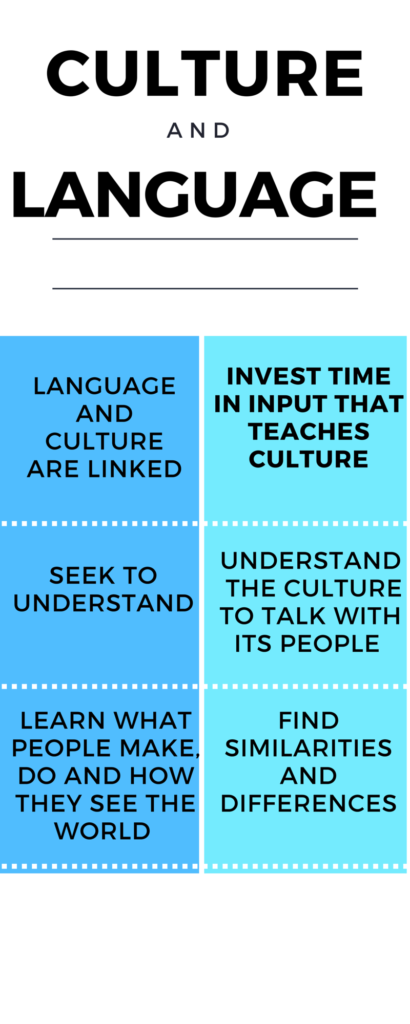
Culture and languages are inextricably linked.
The internet has done so much for language teaching and learning. It’s just amazing when I think back to when I was a language student and what we had available to us, and what’s available to me now. I remember the days of grammar exercises, flash cards, language labs and the special, occasional treat when you could watch a film or actually read a magazine in a foreign language. Now, authentic language and culture is available to us everywhere.
You can hear radio from all over the world. You can see television from all over the world. We can read Facebook posts from people in target language countries. We can read daily newspapers and articles from other journalists on blogs and get lots of contact with native language and culture. We can actually connect with people from halfway around the world.
Having said all of that, I’m still not convinced that we do give interacting with culture the importance and the understanding that it truly deserves. You’ll never speak a language if you don’t have lots and lots of contact with its culture. Learning a language isn’t just learning a bunch of words and codes. It’s not just Anki flashcards or different mathematical-based systems, but actual contact with what people in the target language culture do, what they make and what they believe.
Language and culture are inextricably linked; you can’t take them apart. You will not learn a language if you don’t learn it’s culture, and you will not be able to avoid learning about culture in truly learning a language. For example, take Spanish. You will learn that there are four different ways to say ‘you’ in Spanish that are taught in school (we generally don’t even touch on el voseo). In order to address someone more appropriately, you need to acknowledge their relationship with you. Is it formal or informal? You also need to understand that that relationship-formal versus informal-is very important in Latin America, and not as important in Spain. And in fact, by using formal language with somebody in everyday Spanish life, you run a very good chance of alienating them. They might think you are being cold. It can almost be like calling a woman Ma’am or Madam. It could be perceived that you think the person is older.
We have a similar scenario in French with ‘tu‘ and ‘vous‘. When is it appropriate to use formal language and when is it appropriate to use informal language? Oftentimes the formal language form in French is taught first. You might not know a lot of French people when you are just starting. Also, in terms of efficiency, ‘vous‘ is also the plural of ‘you’. You’ll get more communicative power out of learning the ‘vous‘ forms. However, you need to understand that it is formal so you don’t alienate people you didn’t mean to alienate. In Korean, there are many instances in which people are addressed according to their relationship. There are different words, for example, for older sister or for older brother. In order to get the person’s relationship described appropriately, you have to know completely different sets of words.
ACTFL defines culture as the products, practices and perspectives of the people that speak the target language. Language and culture are completely linked. You can’t learn one without the other. Here are my tips to learn culture and language simultaneously.
Seek to understand. I can’t overstate the importance of seeking to understand. At the end of the day, people are more alike than they are different. Having said that, life is different in different cultures. In order to be able to communicate with these people, you’ve got to understand where they are coming from. You’ve got to understand that they are going to see the world a little bit differently. Their culture might see the same issue in a completely different light than you might, and it could spark conflict. You have got to try to see through a different lens to understand. This is how we learn languages. We understand first.
I also think when you’re in a new culture and you’re learning a new language, you have got to learn how to really listen. Someone once said we have two ears with which to listen, and one with which to talk. I couldn’t agree more. This is research-based in terms of learning a new language. We learn languages by understanding (Krashen).
Learn what people make, do and how they see the world. Learning about what people make, what they do and how they see the world can tell you so much about their language and culture. You will learn so much new vocabulary along the way.
I think when we talk about learning what people make, I’ve always found a really interesting side of culture to be the foods. Not surprisingly, Spain and Japan are close to the sea, and they eat a lot of seafood. And they have all these amazing, unique dishes based on their geography. There are unique vocabulary words that you’d never learn otherwise.
We also think about what people do. I think about how almost, if not every, city in Spain has a patron saint and a festival celebrating that person. People celebrate their name day more in a manner that would be expected for a birthday in Greece. People are individuals, but the things they do in their culture are going to hugely shape the way they see the world.
Invest in input that teaches culture. I am a huge fan of so many of the cool things that are out there online nowadays. There are Anki flashcards, where you can insert your own video and sound. I love all the grammar tutorials, the verb games and activities on sites like Quizlet.
I think those things are fabulous, but I think they’re overemphasized as ways to learn languages. People need to spend more time reading and listening in a new language, and those resources are available all over the place online. The input is you’re really going to get you into that target language. You’re going to get grammar and vocabulary completely in context. It’s nice to read some of your favorite books in a new language, or an author you might normally read in your own language in the target language, but you’re missing the entire culture piece. You should do your very best to read and listen to products created by native speakers of the language you’re learning. They’re all over the place online, and they’re free. There are YouTube videos, television shows, blogs, magazines, newspapers and radio. In the novice level, the flashcards and games are great, but nothing will bring you into fluency like engaging with authentic language and culture.
Understand the culture to talk with its people. This goes back to language and culture and how they’re linked. To really and truly talk to people, you have to understand their culture and what they value. For example, if you go to a Chinese person’s house, it’s really important to compliment something there. I think we do similar things in English-speaking culture, but it’s important to know cultural norms to make people feel comfortable with you.
On the inverse of that, people aren’t always as rude as they might come off. I’m an American from an Eastern European family, and it took me some time to understand where some of the bluntness of things people in my family would say to each other came from. That’s part and parcel of some of these cultures. You can be very direct and it’s okay. I believe the same to be true in Korean. Sometimes people will say things that seem like insults (i.e. “You look too tired today. You don’t look very good.”). In their culture, it’s completely acceptable to comment on appearance. If you look good, you’re going to get a comment. If you don’t look so good, you’re probably going to get a comment.
Find similarities and differences. The way to really assimilate all of this information and to truly be able to talk to people beyond ordering food and other basic interactions, is to put this understanding all together. And in doing so, you’re going to find the similarities and differences. It’s when you really understand those similarities and differences that you learn how to relate to these people. Relating to people and communicating with them is the only thing speaking a language is really about. At the end of the day, it’s all about understanding each other. We’re a lot more alike than different.
A few practical ways to incorporate culture into your language learning routine.
- Netflix for films and series.
- Yabla– content made comprehensible for learners.
- Spotify- target language music and podcasts.
- Readlang. Read target language content.
- Youtube tutorials.
Check out the lab here: https://real-life-language.teachable.com/p/the-5-week-linguist
